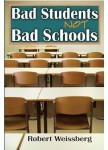Bad Students, Not Bad Schools

|
Title | Bad Students, Not Bad Schools |
| Author | Robert Weissberg | |
| Reviewer | George Leef | |
| Review Date | July 2, 2013 | |
| Publisher | Transaction Publishers | |
| Year | 2010 | |
| Rate this Book |
Political science professor Robert Weissberg has been writing iconoclastic books that challenge the conventional (i.e., predominately progressive) wisdom on social issues for many years, and with this book he focuses his attention for the first time on America’s woeful public education system. He dares to say what many writers fear to—our educational beliefs and policies are for the most part delusional nonsense. That nonsense serves wonderfully the interests of the education establishment—teachers, administrators, non-teaching staffers, union officials, professors of education, program officers, our grant-making foundations, and so on—but it leaves students stuck in schools that just go through the motions of education. But to a large degree (and here is where the book reaches the pinnacle of iconoclasm), that suits the students fine because many couldn’t care less about learning.
As the book’s title implies, our schools do a bad job mainly because the students themselves are bad. Many are not the least bit interested in learning. They dislike reading (and are not good at it), disdain rigorous thought, and see no point in developing beneficial traits through discipline and work. While Weissberg may seem to relish the “liberal” sin of blaming the victim, his purpose is to expose the folly of just about everything called “education reform,” including both progressive and conservative notions about how to “save” or at least improve our schools.
The essential problem is that those ideas share the false premise that all students can learn and want to. Great numbers of young Americans, especially those from “underrepresented minority groups,” however, grow up in homes where education is not prized and among peer groups that not only ridicule studiousness but reward those who are best at “acting out.” Adolescents like that can’t be turned into even moderately successful students no matter how much money is spent on the schools, personnel, and programs meant to make learning seem more relevant and fun.
But this isn’t only a “minority” problem. White youth culture is also quite inimical toward academic effort. Studying just isn’t “cool.” Weissberg writes, “An extremely high proportion of students fail to take school seriously—they spend countless hours ‘goofing off’ with friends, often cheat on tests or rely on the homework of others. For many, attending classes is just a nuisance—between a third and 40 percent admit they are not paying attention or not trying hard. Teachers routinely report having classes where half the students seem ‘checked out’” (37-38).
Weissberg buttresses his argument that student attitudes matter far more than the schools they attend by pointing to the facts that a) many Asian students who come from lower-class families and attend public schools with bad performance records on the whole manage to excel academically and b) many black students from prosperous families who live in nice suburbs with “good” schools (e.g., Shaker Heights, Ohio) still do poorly on standardized tests. Having a positive attitude toward school and a family that supports learning appears to be both a necessary and a sufficient condition for academic success. The schools themselves are at most a marginal influence.
Nevertheless, education “experts” keep advancing panaceas for fixing the schools. The only idea they won’t tolerate is that of encouraging indifferent and disruptive kids to leave so that the remaining students will have a much better learning environment. That idea is taboo, especially with President Obama telling us that it’s vital for an increasing percentage of Americans to graduate from college. All the experts insist that we must devote more and more resources to student retention—that is, keeping disinterested and disengaged students in school with any gimmicks the educators can think of.
Perhaps the most infamous of the many “let’s give poor kids great schools and they’ll make progress” programs was the Kansas City, MO experiment begun in 1985 when a federal judge told school reform zealots to “dream big.” They came up with a long and expensive list of improvements to inner-city schools so that the racial achievement gap (a bête noire that recurs again and again in the book) could be closed. The reformers drew up plans for Taj Mahal schools equipped with everything from Olympic-sized swimming pools to a model United Nations assembly complete with simultaneous language translations. (The judge ordered that taxes be increased to pay for this utopian vision of “good schools.”) And the results? No improvements whatsoever in student achievement. If good—in this case, gold-plated—schools mattered, we’d have seen wonderful progress in Kansas City, but we didn’t.
Weissberg makes a compelling case that bad students are the main reason why the country has such a low level of academic prowess. (The National Assessment of Adult Literacy (2003), for example, found that less than a third of college graduates were “proficient” in prose literacy.) We spend lavishly on “education” and get pathetic results. Weissberg doesn’t lay the fault entirely on students; he also shows that many of our schools are also bad, with teachers who are indifferent or incompetent (but can’t be fired thanks to union rules), materials and curricula that have been dumbed-down, programs that ignore gifted students but lavish attention on the weakest ones, and are susceptible to educational fads emanating from our “colleges of education.”
Those topics take up most of the middle of the book. Weissberg, retired from the University of Illinois, now lives in New York City and writes with relish about the innumerable follies of public school reform in New York. The politicians, from Mayor Bloomberg on down, have to pretend that they’re doing something to improve the schools—every politician needs to be able to say that he’s “pro-education.” In New York (and most other cities), elaborate deceptions surround school performance so that heavily publicized plans appear to be working. Of course, they don’t work because nothing really changes. The students are still mostly uneducable, the teachers are still unmotivated and/or incompetent, and the system still encourages that students be passed even if they have learned nothing. The way the once rigorous New York Regents Exam has been watered down is emblematic of the problems that plague public education across the nation.
One of the author’s prime targets is misguided philanthropy. Ever since the Ford Foundation decided that fixing public education would be one of its goals back in the early 1960s, foundations have been pouring money into education. The problem here is that supposed experts often convince foundation officials (who tend to be utopians, easily led into supporting “progressive” theories) to back their visions. For example, Weissberg notes that a lot of foundation (and business) money has gone into programs intended to increase the number of “minority” students in math, science, and engineering. If American businesses really need more home-grown talent (many positions requiring such expertise are currently filled with foreign workers), it would make far more sense to try recruiting them from populations where students are more likely to have the aptitude and interest that is necessary. But political considerations demand programs that aim at ironing out group inequalities, so we spend tons trying to make math and science appealing to black and Hispanic kids, few of whom have thus far shown much interest or ability.
Foundations could, Weissberg argues, do considerable good if they targeted their grants toward school programs to help our best students advance faster, but that won’t happen because of the firmly entrenched egalitarianism at most of them. Many donors would rather bask in the glory of publicity for programs that sound good even though they are just flushing away money on ideas that have already failed.
As I mentioned above, Weissberg is not a fan of “conservative” school reform ideas either. He does not think that Milton Friedman’s idea of expanding parental choice through vouchers will accomplish much good. That is because most parents already have a range of choices other than “their” public school. Even in the inner cities, parents who want their children to receive true education as opposed to the vapid faux-education given away in the public schools have choices. There are fairly low-cost private schools and tutoring services that could make up for the deficiencies of the government schools. Only a small number of parents spend the time and money to avail themselves of such choices. Weissberg comments, “Put bluntly, many poor parents must choose between extra academic help for junior versus cable TV or a cell phone, so to insist that they ‘lack choice’ only flatters their disdain for education” (210).
The book concludes with perhaps the author’s most provocative argument of all, namely that our public education system has evolved into a branch of the welfare state. “Bloated, unproductive school payrolls,” Weissberg writes, “exist as a form of socially-acceptable bribery for those otherwise incapable of achieving a decent middle-class life. Watered-down diplomas similarly provide the happy illusion of ‘education’ to youngsters who might otherwise be driven by mayhem” (262).
That, I think, is a very useful insight. In real markets, where people exchange money for value and can take their money elsewhere if they don’t get it, scams and frauds can’t long survive. Once we put politics into them, it’s inevitable that savvy interest groups will attach themselves like lampreys and begin to parasitically feed off the flow of tax money. Americans have long had a hard time saying “no” to anything that is labeled “education” and have come in the past century to say “yes” to almost anything that promises “social justice.” What might be admirable values when pursued through private institutions turn the public treasury into a lush field for grazing by our education establishment. And the worse its results, the more money it can demand, as long as it blames our culture of injustice rather than acknowledges its own failures to attract and engage students and help them attain a serious education.
After such a strong indictment of American education, it would be incongruous for Weissberg to end on an upbeat note. He doesn’t. The book ends with a resigned shrug. Our education system has been wrecked—for the majority of students, at least—and the combination of interest group politics and the anti-education mentality that goes with welfare dependency will prevent any beneficial change. That is a depressing but realistic assessment.
Despite editing that leaves much to be desired, Bad Students, Not Bad Schools is an excellent book that counter-balances the profusion of happy-face books and reports saying that our education is good and only needs more funding to get better. It isn’t good and we should stop throwing away money on political fixes.
George Leef is the Director of Research at the John W. Pope Center for Higher Education Policy. He holds a BA from Carroll University in Wisconsin and a JD from Duke University. He was on the faculty of Northwood University in Midland, Michigan from 1980 through 1989 teaching economics, business law, and logic and is the author of Free Choice for Workers: A History of the Right to Work Movement (2005).



